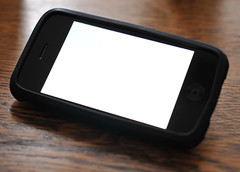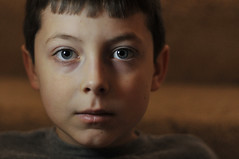 The LED lights that come built-in to our cell phone cameras are generally useless. But not so the lights built into the cell phone screens themselves.
The LED lights that come built-in to our cell phone cameras are generally useless. But not so the lights built into the cell phone screens themselves.I am pretty much married to my iPhone now. Well, maybe not technically, but we are sleeping together. I am a huge fan of the BBC podcasts: Global News, Business Daily, FOOC, etc., and listen as I fall asleep.
Something else I am digging on the iPhone: Using the free MyLite app, you can turn your iPhone into a little 2x3.5" light panel that is surprisingly close to daylight balance...
__________
Mrs. Right vs. Mrs. Right Now
Using a cell phone as a light source is kinda like the old CSN song, "Love the One You're With." Is it gonna light a group shot? No. Is it gonna nuke the sun? Hardly. But it is available.
 And what it can do is to get a little kiss of light in there that can provide a nice accent in a low-light shot. In a pinch it can be a quickie, hand-held key light at close range if you are shooting in very poor ambient.
And what it can do is to get a little kiss of light in there that can provide a nice accent in a low-light shot. In a pinch it can be a quickie, hand-held key light at close range if you are shooting in very poor ambient.Think twilight, or night shot, handheld with some of these ISO-Wonder Cameras like the D3 and 5D Mk II. Shoot with your right hand, add a little close-up light in with your left. Especially when you a shooting something moody against waning sunset, or just want a kiss of normal color light on someone's face on a night street shot.
The phone is wireless, flat, can be taped anywhere -- lots of possibilities. As long as you recognize its limitations (low light only) the ideas just start to pop into your head.
A Tripod Makes it Brighter
Of course, since the light is continuous, time (and a tripod) is your friend in a darkened room. Additionally, you can move it around during the exposure, so you can make the light source do things that a static flash could not possibly do.
Reader Jann Lipka, of Stockholm, demonstrates by using his cell phone screen to "light paint" a photo which was shot with a PhaseOne back. (How's THAT for a budget mismatch!)
(Via Jann Lipka, on Vimeo.)
You may at first write this off as a gimmick, but just realizing you always have that little light source with you can spark you to find ways to use it.
Little Lights for the Big Boys
Hollywood has already latched onto the idea. If you happened to pick up a DVD of the movie "Collateral," with Tom Cruise and Jamie Fox, check out the extras on disc 2. There is a feature on how they filmed all of the car scenes at night without lighting the exteriors. They just cranked the gain (it was shot digitally) and let the exteriors light themselves.
This left the interior of the car far too dark -- but remember that exposure level was very low. Enter flat-panel lighting. Michael Mann used (if memory serves) flexible panels which were originally designed to be backlights for laptop screens. He simply covered the interior of the back of the car in black velcro (ceiling, backs of the seats, etc.) so he could position the flat-panel LEDs wherever he wanted for the different shots.
This is way cool, IMO, and brings a whole new ethic to lighting the scenes. You are letting the ambient do the heavy lifting, and shaping up your primary subject matter with small lights that do not need to be very powerful. Sound familiar?
You can see the results of this "shaped ambient" style of lighting throughout the whole movie. I like it, and hope to do some low-light shooting with this technique first chance I get.

If you wanna play like Mann but need a little more light than your cell phone, you'll want to pick up a Rosco LitePad HO, pictured at left.
These are far brighter than you cell phone, and can run on 110v, cig lighter, or AA's. It is essentially a matrix of LEDs in a stiff, flat panel that is about 1/4" thick. They start at about $100 US for a 3x6" panel which is rated at 6000K for color.
For still shooters, they would be pretty specialized. But for the PJ's out there who are looking to do multimedia with a 5D Mk II or a D90, the LitePad would certainly merit a little space in your Domke. They are small, thin and rugged -- and ready to go whenever you need an accent in a low-light situation.
Have you put a normal cell, an iPhone or a store-bought panel into service for a shot? If so, hit us in the comments with a URL to the results.




0 comments:
Post a Comment